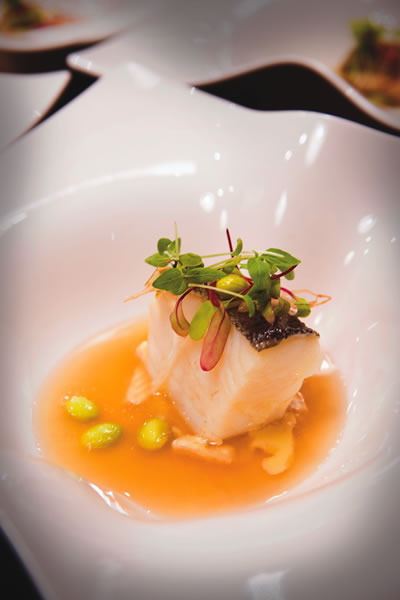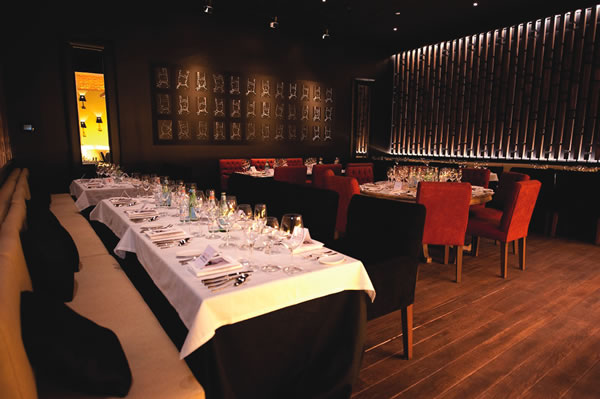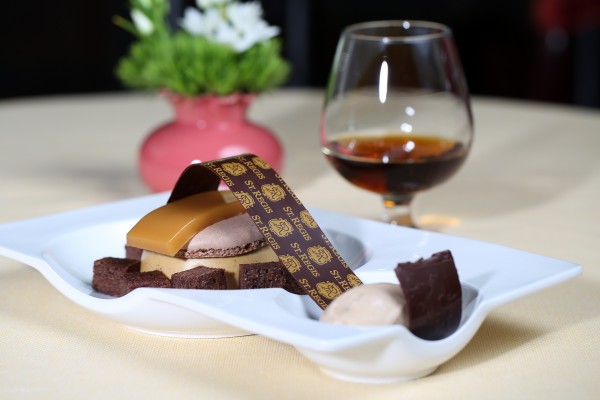Exclusive dinner club Estudio Millesime brings a one-of-a-kind concept to fine dining.
By Michelle Franzen Martin
Guests use a private code to enter through an iron gate that leads to the open kitchen and dining area. The space is industrial and dark, its brick walls and wood floors giving an understated nod to its centerpiece—the gorgeously illuminated open kitchen.
This is Estudio Millesime by American Express, on the ground floor of The St. Regis Mexico City. Here, one-of-a-kind culinary creations by some of the world’s most globally recognized chefs are served in an intimate setting. Only 80 companies, now including St. Regis Hotels & Resorts, are members of the private gastronomic club whose clandestine design reflects its exclusivity.
A New Tradition
Mexico City has evolved into a world-class culinary destination with everything from open-air markets to high-end restaurants serving cuisine as flavorful as the city itself. The dishes are interesting and diverse. The ingredients are local. The city, particularly in recent years, has become something of a gastronomic mecca—a place where world-renowned chefs flock to draw inspiration from the surroundings and open restaurants that are uniquely Mexican. And now, with the opening of Estudio Millesime, that tradition continues.
“Estudio Millesime is a space that I thought of … as perfect to welcome my family, associates and friends,” says Manuel Quintanero, president and founder of Millesime, a culinary brand whose reach extends throughout Spain, Latin America and beyond. “It seems that everyone is looking for the same magical place to call their own.”
With seating for only 40 guests, Estudio Millesime is undoubtedly exclusive. It was inspired by Millesime events in Madrid, Brazil and the Dominican Republic—a concept where the world’s top chefs are selectively chosen to create dishes for an exclusive group of several hundred guests. Like the Millesime events, the guest chefs at Estudio Millesime rotate frequently; but unlike those events, the St. Regis dinner club is a permanent fixture in Mexico City.
“We had this idea of creating a permanent Millesime, a space directed to a much smaller group of people, but applying the same criteria, the same foundations, the same basis applied at Millesime—exclusivity, absolutely exceptional creations, and creations directed toward companies,” Quintanero says. “We have created quite an adequate setting to receive the great master chefs who will be visiting the studio.”
Jacqueline Maria Benitez, who directs communications for Millesime and Estudio Millesime, says it’s a unique concept like no other. “The location captures Manuel Quintanero’s soul and spirit as a lover of the culinary scene,” Benitez explains. “The surroundings are a perfect fit for Estudio Millesime since The St. Regis Mexico City in a short time has became a landmark of the city and one of the most prestigious addressees in Mexico.”
Quintanero, who designed the Estudio Millesime space, says he was inspired by his passion for design and architecture: “My children describe me as a frustrated architect and indeed I am,” he says. “I love beauty in all its forms, and I feel that designing comes from within when you have a clear approach and can recognize that simplicity is a great form of elegance.”
The dining area itself is a work of art. The tables were sourced from Indonesia and the plush chairs that accompany them are as forward-focused in design as they are luxurious and comfortable. Bold half-cut lamps hang to provide soft lighting as well as unique design detail. The space also includes a library for culinary books that were gifts from chefs around the world—each one dedicated to Estudio Millesime.
One particularly interesting part of the design is a large mural that depicts line drawings of chefs. In the center, flanked by those outlines, are the chefs who have visited Estudio Millesime. And as the list of guest chefs continues to grow, their photographs will be added to the ever-changing mural, which constitutes a provocative conversation piece.
Welcoming a Legend
Estudio Millesime opened in February with an appearance by Joan Roca, the founder and world-renowned chef of Spain’s El Celler de Can Roca, which has earned three Michelin stars and in 2012 was deemed the world’s No. 1 restaurant by an international poll of chefs, restaurateurs and critics organized by Britain’s Restaurant magazine.
Roca, who created a six-course tasting menu, says he was drawn to Estudio Millesime for a number of reasons.
“I understood that this was quite an important project,” he says. “It would change things, plus it was a challenge. I just had to be here. Mexico also did its part with its magnetism. I knew I would come to a country where I have friends, people I can trust, and I knew it wouldn’t be hard to find very good products.”
Mexico City’s high-quality seasonal produce, grains and other ingredients are a draw for chefs who visit the area. Roca says he also was attracted to the Estudio Millesime concept itself.
“The team was extraordinary; the facilities were perfect,” he says. “It has been a very pleasant surprise to find so much affection, so much consideration and so much recognition. This is probably the place where I have found the most affection and consideration than anywhere else I have been in the last few years.”
There is a strong emphasis on culinary arts in Mexico City, Quintanero says, and that will continue to grow. Estudio Millesime, naturally, will continue to grow with it.
“The great master Ferran Adrià said the difference between a great restaurant and a good restaurant is that at a good restaurant you eat very good food and you talk about anything else, but at a great restaurant you eat very good food and you talk about what you’re eating,” Quintanero says. “This is what’s going to happen to Mexico’s gastronomy. There is great gastronomy already, but very soon people will talk about what they’re eating.
“And the chefs that come here confirm how much love and interest is put into gastronomy—they realize how interesting it is to display what they do in the super-powerful market that Mexico is,” he adds.
International Influences
Although Estudio Millesime is based in Mexico and Quintanero is Spanish, the menu varies considerably and dishes are not exclusively Mexican or Spanish.
“It is not a rule for the presentations to be from one country or the other,” Benitez says. “The flavors depend on the chef’s selections and the array of flavors, techniques and styles they bring to the table and menu.”
Roca, for instance, created an eclectic tasting menu that was paired with wines from around the world. His menu creations included smoke-dried octopus with smoked paprika, paired with Dom Pérignon Vintage 2003; Mediterranean dab, paired with California wine Mer Soleil Silver 2010; pork blanquette with Pfalz riesling, paired with Spanish wine Numanthia 2008; and cod escudella, paired with Spanish wine Roda I 2006. He also served oyster cava and nuvol de
llimona for dessert.
This fall, Estudio Millesime will welcome a balance of Mexican and international chefs, including Mexico-based Enrique Olvera, ranked the No. 17 chef in the world by San Pellegrino’s acclaimed list. Estudio Millesime created a Saborea Mexico program, designed to bring only the best chefs from Mexico to cook a six-course meal with three chefs per event. The chefs include Ricardo Muñoz Zurita, Guillermo González Beristain, Diego Hernández-Baquedano and Xavier Pérez Stone. Peruvian chef Virgilio Martínez, ranked among the world’s 50 top chefs, also is scheduled to visit Estudio Millesime this fall.
A great deal goes into receiving the world’s best chefs—including checking to be sure a chef’s desired menu ingredients are available—but Mexico City is the ideal place for it to happen. B
Culture Roots
Mexico City is known as the “Rome of Mexico,” a culinary hub where the freshest fruits, vegetables, grains and other ingredients continue to entice both chefs
and restaurateurs.
“It has become one of the most international cities in terms of culinary and cultural offerings,” says Ana Garcia, a Mexico-born chef and restaurant consultant who has trained chefs from around the world. “You can literally find every type of cuisine represented in the restaurants of [Mexico City].”
That’s become especially true in the last 20 years, as the city has burgeoned into a culinary center. Still, Mexico’s history remains an important influence on Mexican cuisine.
“Mexican chefs are forced to have one foot in the past and one in the future,” Garcia says. “Even if a chef breaks out and does something modern or a type of fusion, it always has some link to the Mexican culinary tradition or history. It is a great culinary legacy.”
Mexican cuisine blends indigenous and Spanish influences, with ties to the country’s history of French occupation, Lebanese immigrants, German Mennonites, as well as influences from the Dutch, Arab, Japanese and Chinese cultures. Ingredients vary by region, but staples include chilies, rice, beans and corn. Other popular ingredients include squash, cactus and tomatoes.
With the new dining concept that Estudio Millesime has brought to Mexico City, the culinary offerings will only continue to grow and evolve here, says Javier Gonzalez, a Mexico-based chef who founded the Culinary Art School in Tijuana and has trained a number of top chefs.
“Estudio Millesime is a great addition to the gourmet concept,” he says. “In the culinary world, we are all very curious, and we are always tempted by new flavors. So having new influences from all over the world will just help us continue evolving the culinary process. We will continue learning new concepts … to perfect our craft.”

International Influences
Although Estudio Millesime is based in Mexico and Quintanero is Spanish, the menu varies considerably and dishes are not exclusively Mexican or Spanish.
“It is not a rule for the presentations to be from one country or the other,” Benitez says. “The flavors depend on the chef’s selections and the array of flavors, techniques and styles they bring to the table and menu.”
Roca, for instance, created an eclectic tasting menu that was paired with wines from around the world. His menu creations included smoke-dried octopus with smoked paprika, paired with Dom Pérignon Vintage 2003; Mediterranean dab, paired with California wine Mer Soleil Silver 2010; pork blanquette with Pfalz riesling, paired with Spanish wine Numanthia 2008; and cod escudella, paired with Spanish wine Roda I 2006. He also served oyster cava and nuvol de
llimona for dessert.
This fall, Estudio Millesime will welcome a balance of Mexican and international chefs, including Mexico-based Enrique Olvera, ranked the No. 17 chef in the world by San Pellegrino’s acclaimed list. Estudio Millesime created a Saborea Mexico program, designed to bring only the best chefs from Mexico to cook a six-course meal with three chefs per event. The chefs include Ricardo Muñoz Zurita, Guillermo González Beristain, Diego Hernández-Baquedano and Xavier Pérez Stone. Peruvian chef Virgilio Martínez, ranked among the world’s 50 top chefs, also is scheduled to visit Estudio Millesime this fall.
A great deal goes into receiving the world’s best chefs—including checking to be sure a chef’s desired menu ingredients are available—but Mexico City is the ideal place for it to happen. B











